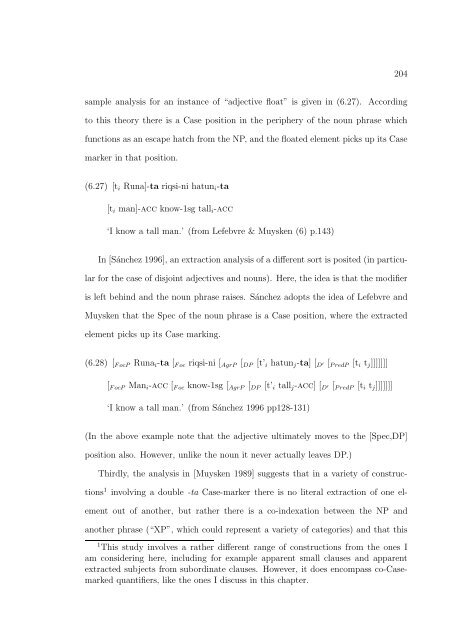the syntax and semantics of relativization and quantification
the syntax and semantics of relativization and quantification
the syntax and semantics of relativization and quantification
You also want an ePaper? Increase the reach of your titles
YUMPU automatically turns print PDFs into web optimized ePapers that Google loves.
204<br />
sample analysis for an instance <strong>of</strong> “adjective float” is given in (6.27). According<br />
to this <strong>the</strong>ory <strong>the</strong>re is a Case position in <strong>the</strong> periphery <strong>of</strong> <strong>the</strong> noun phrase which<br />
functions as an escape hatch from <strong>the</strong> NP, <strong>and</strong> <strong>the</strong> floated element picks up its Case<br />
marker in that position.<br />
(6.27) [t i Runa]-ta riqsi-ni hatun i -ta<br />
[t i man]-acc know-1sg tall i -acc<br />
‘I know a tall man.’ (from Lefebvre & Muysken (6) p.143)<br />
In [Sánchez 1996], an extraction analysis <strong>of</strong> a different sort is posited (in particular<br />
for <strong>the</strong> case <strong>of</strong> disjoint adjectives <strong>and</strong> nouns). Here, <strong>the</strong> idea is that <strong>the</strong> modifier<br />
is left behind <strong>and</strong> <strong>the</strong> noun phrase raises. Sánchez adopts <strong>the</strong> idea <strong>of</strong> Lefebvre <strong>and</strong><br />
Muysken that <strong>the</strong> Spec <strong>of</strong> <strong>the</strong> noun phrase is a Case position, where <strong>the</strong> extracted<br />
element picks up its Case marking.<br />
(6.28) [ FocP Runa i -ta [ Foc riqsi-ni [ AgrP [ DP [t’ i hatun j -ta] [ D ′ [ PredP [t i t j ]]]]]]]<br />
[ FocP Man i -acc [ Foc know-1sg [ AgrP [ DP [t’ i tall j -acc] [ D ′ [ PredP [t i t j ]]]]]]]<br />
‘I know a tall man.’ (from Sánchez 1996 pp128-131)<br />
(In <strong>the</strong> above example note that <strong>the</strong> adjective ultimately moves to <strong>the</strong> [Spec,DP]<br />
position also. However, unlike <strong>the</strong> noun it never actually leaves DP.)<br />
Thirdly, <strong>the</strong> analysis in [Muysken 1989] suggests that in a variety <strong>of</strong> constructions<br />
1 involving a double -ta Case-marker <strong>the</strong>re is no literal extraction <strong>of</strong> one element<br />
out <strong>of</strong> ano<strong>the</strong>r, but ra<strong>the</strong>r <strong>the</strong>re is a co-indexation between <strong>the</strong> NP <strong>and</strong><br />
ano<strong>the</strong>r phrase (“XP”, which could represent a variety <strong>of</strong> categories) <strong>and</strong> that this<br />
1 This study involves a ra<strong>the</strong>r different range <strong>of</strong> constructions from <strong>the</strong> ones I<br />
am considering here, including for example apparent small clauses <strong>and</strong> apparent<br />
extracted subjects from subordinate clauses. However, it does encompass co-Casemarked<br />
quantifiers, like <strong>the</strong> ones I discuss in this chapter.
















